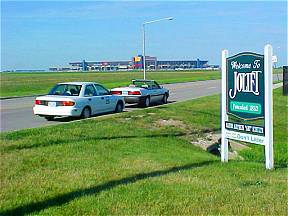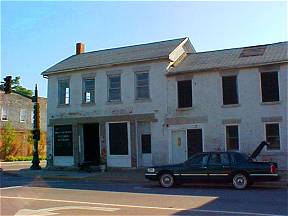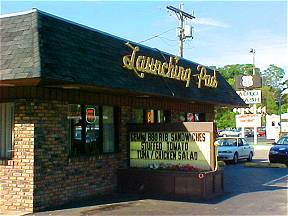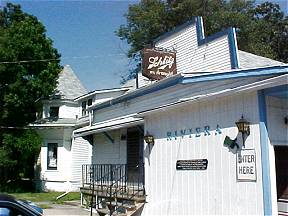|
Joliet Area
|
|
[HOME] [WESTERN AMERICANA GALLERY] [ROUTE 66 HOME] [ROUTE 66 WEST] [ROUTE 66 EAST]
|
Joliet Area
|
|
Joliet, Illinois |
||
 |
There seems to be some confusion about just exactly how the city of Joliet was named. When the original town was laid out back in 1834 the name was recorded as "Juliet" which has prompted some historic speculators to assume the town was named for the Juliet of Shakespeare’s tragedy. Moreover the name of the town of Romeoville (originally know as Romeo), just north of Joliet on Route 66, is said to have been named for Juliet’s companion. The origins of the early names of these two towns are still debated today. It is more likely that the name "Juliet" was a corruption of the name "Joliet" the name of one of the first European explorers to come through the area back in 1673. | |
| Many early communities named their settlements after prominent landmarks in their area. Joliet had one. Mount Joliet or was it Mt. Juliet? On the original 1674 map of the area Louis Joliet named a prominent mound "Mount Joliet" which some later mapmakers corrupted to Mt. Juliet. From 1834 through 1845 apparently nobody was really sure of the name of his or her hometown. Was it Juliet or Joliet? This confusion demanded an official solution. Local town leaders appealed to the Illinois legislature to have this unacceptable situation remedied. The name was officially changed to Joliet in 1845 and the town was incorporated with that name seven years later. | ||
| South of Joliet Route 66 takes on a new appearance. The land starts to open up. Route 66 looks more like the "open road" - that image of the Mother Road that has made her a legend around the world. From here you will enter the world of the two-lane, traveling through timeless towns on a road full of memories. This is the Route 66 experience so many people have sought when they get off the Interstates to see what America was really like once. Route 66 leaves Joliet and heads for Elwood, Illinois. Along this original alignment of Route 66 you will see the Route 66 Raceway. I found the Route 66 Raceway sign particularly interesting because directly in front of it is an old Route 66 alignment marker dating back to the hey-day of the Mother Road. It looked strangely out of place in front of the new raceway sign, a lonely remnant from some past age. |
|
|
| The road continues on towards the small,
quiet community of Elwood. During W.W. II this was a busy place though. The whole area
surrounding this section of Route 66 was once the Joliet Arsenal. Developed in 1942 to
make ammunition for the war it once was the largest producer of TNT in the world. This
open country, far inland and not so vulnerable to attack, prompted the US Government to
locate an arsenal here as they had done at other similar places, isolated places. The
infrastructure of Route 66 and the railroad was already in place and provided a means for
shipping the munitions. Another similar munitions depot is located on old Route 66 in
Belmont, Arizona. Route 66 played a vital role in the war effort. The Joliet Arsenal is now closed and in 1997 the lands it once encompassed have become the Midewin National Tallgrass Prairie and the Lincoln National Cemetery. Once again Route 66 will play a part by providing the gateway to these new incarnations of the old Arsenal. Times have changed but it is nice to see the old road still serving a purpose here. |
||
|
If you take the road from Route 66 to the Lincoln National Cemetery you will find a lonely monument, a memorial that reminds one of the supreme price paid by some in the Joliet Arsenal’s single greatest tragedy. One calm morning in 1942 a violent explosion rocked the countryside. This explosion killed more than forty munitions workers. The cause of the explosion is still unknown. The explosion could have been far worse if the Joliet Arsenal had been located nearer to populated areas; still the blast shattered windows in towns many miles away. This memorial to the civilian workers killed in the blast was dedicated in 2001 just outside the hallowed ground of the new Lincoln National Cemetery. | |
Route 66 and Wilmington, Illinois |
||
|
||
 |
Wilmington is an old town, it was originally known as Winchester when it was founded. In 1854 a dispute over the name Winchester caused the town to be Wilmington. When Route 66 came through town it was a well-established town providing all the amenities a traveler might want. Wilmington has a long history of providing comfort to the traveler too. The historic Eagle Hotel in Wilmington was built in 1836 and served as a stage stop and hotel. There are tales told around these parts that the old Eagle Hotel was part of the Underground Railroad in the days before the Civil War. The old hotel was already 90 years old when it became a part of Route 66. | |
| The Eagle Hotel may well be one of the oldest commercial structures on Illinois Route 66. Imagine the stories that could be told if these walls could only speak. Today it is undergoing extensive restoration and is listed on the National Register of Historic Places. Thanks to the hard work of the new owners the Eagle Hotel will be brought back to life for future generations of road wanderers to enjoy. | ||
| Just down the street from the old Eagle Hotel and more than a century later on old Route 66 you will find the Launching Pad Drive In. It originally opened in the 1950s during the hey-day of Route 66 and has been serving hungry travelers ever since. It is still going strong today. An attraction that causes motorists to rubberneck, pull U-turns and get out and stop at the Launching Pad is its famous Gemini Giant. Once these great fiberglass giants could be found all up and down the Mother Road. Some held various objects in their hands illustrating the type of business that could be found below their gigantic form. Some held mufflers, others held hot dogs, and I remember seeing one as child on one of our family trips, this giant held a big axe and was supposed to be Paul Bunyon. |
|
|
 |
That it made an impression on a young lad like myself is evident if that’s about all I can recall about that trip. I’m not sure where that old Paul Bunyon giant was located, or even where we were going on our vacation. Alas, most of these fiberglass giants have fallen victim to time and the forgetfulness of a nation moving in the fast lane. Forgotten by many perhaps, but not in Wilmington that is thanks to the Launching Pad Drive In. This giant is holding a rocket ship and is a throwback to the days of our country’s fascination with outer space. Cheers to the Launching Pad for preserving a part of our American roadside culture. | |
Braidwood Has Seen the Light |
||
|
Braidwood was
founded in 1865 when a rich vein of coal was discovered quite by accident. William
Henneberry was looking for water, not coal when he struck the coal vein while digging a
well. The boom was on and Braidwood became a major coal-mining town in the 1880s. Today there is much to see from the old Route 66 days. The Polk-A-Dot Drive In is still flipping burgers along Route 66 like they did back in 1956 when they first opened. If you are a fan of the movie "The Blues Brothers" then you will find just a few short blocks from Route 66 in Braidwood the Immaculate Conception Catholic Church. Some people may recognize it from the movie as the place were the brothers "Saw the Light." |
|
Braceville Memorial |
||
| Godely and Braceville are other coal mining towns from the nineteenth century boom days. By 1906 the boom was over and many of the mines had been shut down. Evidently the towns had passed their glory days when Jack Rittenhouse came through here in 1946 because he describes them as remnants of once-thriving coal mining towns with slag heaps blotting the countryside. Route 66 did provide some economic relief though. In fact Godely capitalized on the Mother Road and was known for its red light district in the early days of Route 66. One particular red light business establishment was built right over the county line. This was particularly handy when local law enforcement officials raided the establishment, as they occasionally did. All the patrons had to do to escape the law was to walk to the other side of the house, which happened to be located in the next country, thereby eluding the raiding county’s jurisdiction! | ||
| In Braceville you will find a memorial to Burt Parkenson, put up and maintained by his daughter Pat. Burt was a printer at a local paper who did much to further the cause of Route 66 in the area. His support and love of the Mother Road earned him a place in the Illinois Route 66 Hall of Fame in 1994. |
|
|
Gardner's Gangster's Hangout |
||
 |
The Riviera Roadhouse in Gardner has a fascinating history. Jack Rittenhouse mentions it in his guide book as a cafe at the intersection of the road into Gardner and Route 66. The Riviera Restaurant and Tavern was built in 1928. James Girot, a South Wilmington businessman, moved buildings from Gardner and South Wilmington and put them all together to form the Riviera structure as it stands today. The Riviera is a true roadhouse! Once movie legends Gene Kelly and Tom Mix regularly stopped here. This was a favorite haunt of Al Capone and was known as a gangster hangout too. Slot machines and booze were offered to the discrete customer during prohibition. In fact, there's a freezer in the basement with a heavy iron door that was used to hide booze and gambling machines in case of a raid. | |
| Today the Riviera still serves the traveler a good home cooked meal and a stop at the Riviera is to step back in time to the 1930s and 1940s. Speaking of stepping back, while at the Riviera make sure to step out back and see the old Streetcar Diner. The Streetcar Diner is a preservation project of the Illinois Route 66 Association. The Preservation Committee rescued it from destruction and are in the process of restoring it now. | ||
| The streetcar is over one hundred years old and yes it truly was a horse drawn streetcar at one time. In 1932 George Kaldem purchased it with the intention of converting it into a roadside diner and moved the streetcar to Gardner. This was a no-frills operation, simple and to the point. A small sign on the exterior identified it as a diner, and its reputation for good food soon brought in the customers. For a while it was even used as an unofficial bus stop for the Greyhound line. The diner closed in 1939 but its history was not complete yet. Over the years it became a summer cottage, a children’s playhouse and rental property for workers at the Joliet Arsenal in W.W. II. In 1955 Gordon Gunderson who had married the daughter of Jim Girot, original owner of the Riviera Restaurant purchased the streetcar, and the streetcar was moved once more to its present location behind the Riviera. |
|
|
| It was used as a place for family reunions, picnics, lodging for fisherman and eventually a storage shed. Over the years the diner fell into disrepair until John Weiss, the President of the Illinois Route 66 Preservation Committee discovered it. Restoration then began on this historic streetcar and diner from the early days of Route 66. The dinner is not quite complete yet, but knowing the Illinois crew it will be soon! Thanks guys for preserving a part of our past in Gardner. | ||
Photographs taken June 2003
Click on an area or city of Route 66 on the map below to take a cyber tour of that section of the Mother Road |
| NAVIGATION NOTE: Buckle up and hold on to your mouse! These pages are arranged like the map above, from the western state border to the eastern state border. I have set up this site as if you were traveling from EAST to WEST, much like the Joad family in The Grapes of Wrath. You can click on the Route 66 shields to "travel" the Mother Road in either direction though. Or you can select any shield below to take you to that specific state. | ||
To Dwight, |
To Chicago & |
© Copyright 2001-2004 GRandall Web Design Service